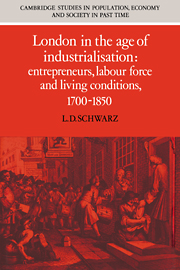Book contents
- Frontmatter
- Contents
- List of figures
- List of tables
- Acknowledgements
- List of abbreviations
- Introduction
- Part I Wealth and occupations in London
- Part II Fluctuations and mortality in the metropolis
- Part III The standard of living and the London trades
- Conclusion: downstream from industrialisation
- Appendices
- Bibliography
- Index
- Cambridge Studies in Population, Economy and Society in Past Time
Conclusion: downstream from industrialisation
Published online by Cambridge University Press: 11 September 2009
- Frontmatter
- Contents
- List of figures
- List of tables
- Acknowledgements
- List of abbreviations
- Introduction
- Part I Wealth and occupations in London
- Part II Fluctuations and mortality in the metropolis
- Part III The standard of living and the London trades
- Conclusion: downstream from industrialisation
- Appendices
- Bibliography
- Index
- Cambridge Studies in Population, Economy and Society in Past Time
Summary
In a much-quoted statement, J. L. Hammond described the industrial revolution as ‘a storm that passed over London and broke elsewhere’. The storm broke at the top of the river, upstream in the production process, where raw materials were changed into semifinished goods – bales of cloth, bars of iron – or finished capital goods such as steam engines. It all took place a long way from London, the goods came down to London, and London adapted itself to them. It did so, not by building factories and competing directly – the cost of factory production in London would have rendered this prohibitive. With its higher costs – its more expensive land and labour, its more expensive coal and the alternative outlets for local finance – manufacturing in London could not compete if its production processes were identical to those of the provinces and the material that it processed cost as much as in the provinces. Where London could compete was by taking advantage of its proximity to the market, its low transport costs and its ample supply of labour. It specialised at the ‘downstream’ end of production, but it could only do so by continually adapting, both to constantly fluctuating markets within the capital and also to falling costs outside the capital. The tendency was to move up-market – fustian manufacture left London during the course of the seventeenth century, framework knitting during the early eighteenth century, the mass production of silk and handkerchiefs increasingly by the late eighteenth century, shoes likewise.
- Type
- Chapter
- Information
- London in the Age of IndustrialisationEntrepreneurs, Labour Force and Living Conditions, 1700–1850, pp. 231 - 240Publisher: Cambridge University PressPrint publication year: 1992



